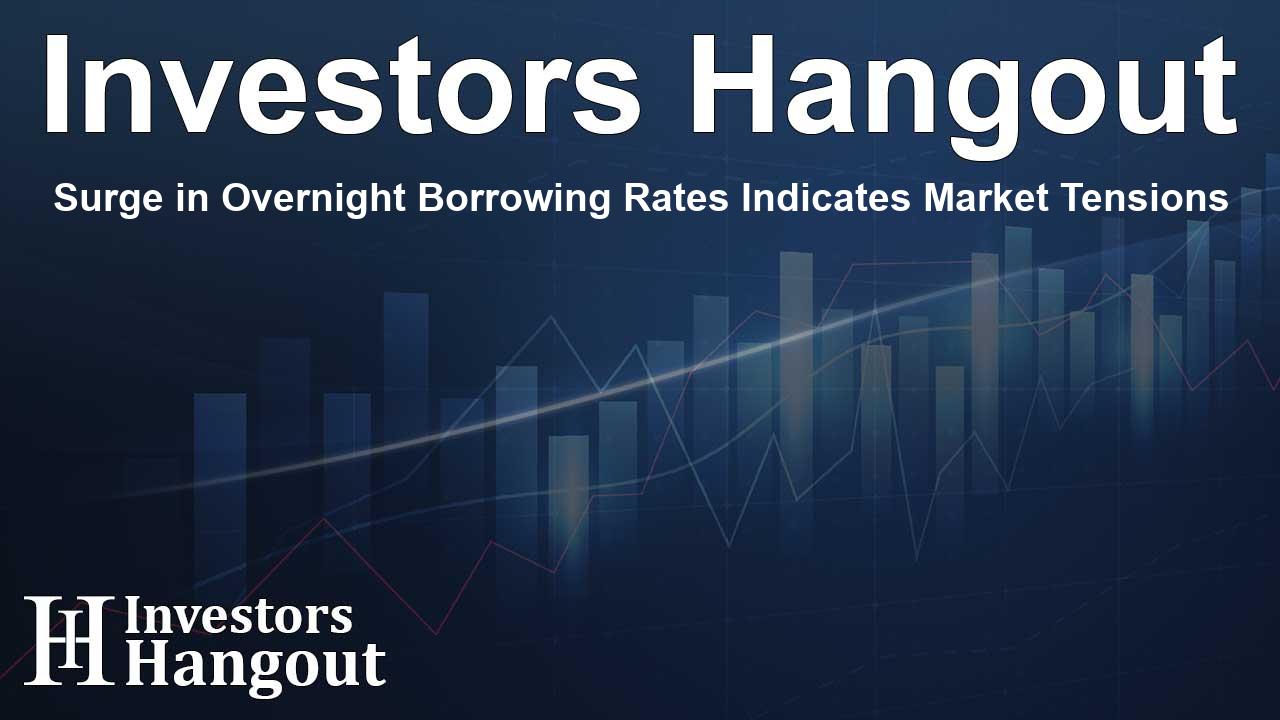Surge in Overnight Borrowing Rates Indicates Market Tensions

Understanding the Surge in Overnight Funding Rates
A notable increase in a key U.S. overnight funding interest rate has recently captured the attention of market analysts. This spike highlights tightening liquidity in the money markets, especially notable at the end of the month and the fiscal quarter. As we delve into the specifics, it becomes clear that this is an essential indicator of broader financial dynamics at play.
What is the Secured Overnight Financing Rate (SOFR)?
The Secured Overnight Financing Rate (SOFR) serves as a crucial benchmark that reflects the cost of borrowing cash overnight, secured by Treasury securities. This significant rate jumped to 4.96%, a considerable rise from the previous week’s 4.84%. Such fluctuations are instrumental for investors and banks alike, as they navigate the complexities of funding and liquidity management.
Important Trends in the SOFR
Data sourced from the Federal Reserve Bank of New York illustrates that this recent increase in SOFR marks one of the largest one-day changes seen since March 2020, excluding periods surrounding Federal Reserve policy alterations. This dramatic shift is an expression of the underlying funding pressures present in the current market landscape.
Key Market Indicators
Alongside the rise in SOFR, the DTCC GCF Treasury Repo Index recorded an increase to 5.221%. This rate is crucial as it tracks the average daily interest rate for the most-traded General Collateral Finance (GCF) Repo contracts involving U.S. Treasuries. The situation is particularly telling, with the index appearing roughly 32 basis points above the interest on reserve balances (IORB) paid by the Federal Reserve to banks.
Analyzing the Market Turbulence
Angelo Manolatos, a macro strategist at a leading financial company, noted that current volatility in repo markets points toward increased funding pressure. During periods of rising borrowing rates, such as this, a sudden spike in the cost of repurchase agreements, or repos, is often indicative of tightening cash availability—a central concern for Wall Street funding markets.
Historical Context and Implications
The scenario reflects past trends, particularly a similar spike in short-term funding costs in September 2019, which compelled the Federal Reserve to step in with liquidity support. Such historical context is essential for understanding the gravity of current developments and their potential ripple effects through the economy.
Quarter-end Effects on Funding Rates
Market professionals have observed that repo rates typically see an uptick at the end of quarters, driven by balance sheet reporting needs. This phenomenon prompts dealers to scale back their aligned activities, impacting overall borrowing rates. However, the recent dramatic escalation on Monday suggests that banks find their balance sheet capacity significantly less available and much more costly than previously anticipated.
Conclusion: The Road Ahead
The dynamics of the funding market are crucial for economic stability and growth. As the U.S. economy faces various challenges, understanding shifts such as those in SOFR or the DTCC GCF Treasury Repo Index is vital for assessing financial health. Stakeholders must remain vigilant and adaptive in this ever-evolving landscape, marked by unique pressures and opportunities.
Frequently Asked Questions
What caused the recent increase in SOFR?
The recent increase in the SOFR is primarily driven by tighter liquidity conditions in the money markets at the end of the month and quarter, reflecting heightened funding pressures.
Why are repo rates usually higher at the end of quarters?
Repo rates typically rise at quarter-ends as financial institutions adjust their balance sheets, leading dealers to limit their matched book activities.
What does a rise in the DTCC GCF Treasury Repo Index indicate?
An increase in the DTCC GCF Treasury Repo Index signals a higher cost of borrowing for repos, which can suggest liquidity constraints in the market.
What is the significance of the interest on reserve balances (IORB)?
The IORB is the interest rate that the Federal Reserve pays banks on their reserve balances, serving as a key benchmark in assessing liquidity and funding pressures within the banking system.
Are there historical precedents for these spikes in funding rates?
Yes, similar spikes in funding rates have occurred in the past, notably in September 2019, prompting the Federal Reserve to inject liquidity into the markets to stabilize conditions.
About The Author
Contact Thomas Cooper privately here. Or send an email with ATTN: Thomas Cooper as the subject to contact@investorshangout.com.
About Investors Hangout
Investors Hangout is a leading online stock forum for financial discussion and learning, offering a wide range of free tools and resources. It draws in traders of all levels, who exchange market knowledge, investigate trading tactics, and keep an eye on industry developments in real time. Featuring financial articles, stock message boards, quotes, charts, company profiles, and live news updates. Through cooperative learning and a wealth of informational resources, it helps users from novices creating their first portfolios to experts honing their techniques. Join Investors Hangout today: https://investorshangout.com/
The content of this article is based on factual, publicly available information and does not represent legal, financial, or investment advice. Investors Hangout does not offer financial advice, and the author is not a licensed financial advisor. Consult a qualified advisor before making any financial or investment decisions based on this article. This article should not be considered advice to purchase, sell, or hold any securities or other investments. If any of the material provided here is inaccurate, please contact us for corrections.
